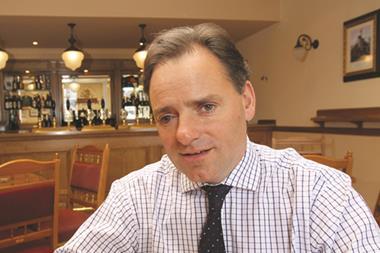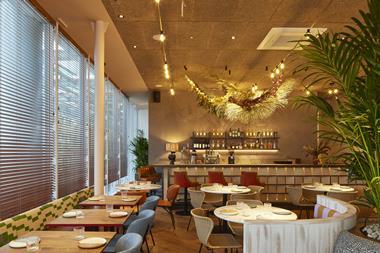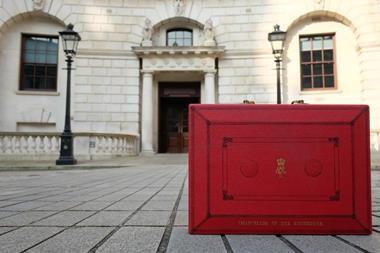The pub sector is as fast-moving and energetic as I can ever remember it. We seem to have emerged from the smoking ban and, fingers crossed, the economic recession, with a renewed sense of vigour. There is so much energy and a real sense of blurring of the lines between pubs and restaurants; casual dining and fast casual. Pub operators are investing in their sites and pubs are much more appealing.
All of this has been a real benefit to customers in the past five years. They have seen a real improvement in the offer, service and amenities – all at affordable prices.
Simon French said recently that the UK eating and drinking-out market is worth about £75bn – if you strip out the under-18s then that £75bn is spent by about 50m people, meaning about £1,500 per head of adult population a year or £30 a week. It’s worth thinking about that because it’s related to the fact that average discretionary income for the average UK family is about £170. It’s not a huge amount and when people spend it, they don’t want to waste it. It doesn’t take a genius to work out that the average family isn’t eating out every night of the week and if they do it’s not at the Ivy. Across the UK as a whole, value is critically important.
It illustrates one of the key strengths, but also one of the key challenges, for the pub sector. At Marston’s, we build 25 to 30 new pub-restaurants each year and spend about £80m a year doing that. But people often don’t know what we do and assume that when we invest £3m in a site we ought to be building high-spend-per-head pubs at the top end of the market. I’m often asked if we’re building gastropubs. We build great pubs but we also build high-volume business models focused on operating a premium experience at affordable prices.
We are not the lowest price in the market but we are affordable and what we look at is value as a product and price of experience, not just offering the lowest price. We think that is the real sweet spot in today’s market. Other competitors may have lower prices, but it is the perceived value that is important to me. A consequence of that is that our customer base is cut across a wide range of income and demographic groups. They get different things from the kind of pubs we build: convenience, socialising, celebration – and that’s a great set of attributes and customer promises to have within one building.
Pubs at an affordable price don’t have to mean basic service, they don’t have to mean inferior food and drink or a run-down pub. We’re not like no-frills airlines or supermarkets using self-checkout tills solely to get you out of the building quicker.
So, what does this mean in practice? Our average spend per head on a meal and a drink is about £10. What it boils down to is that when a customer comes to one of our pubs I want them to say “that was great, I want to come back next week”. What I don’t want them to say is “that was great, I’m going to come back for my next birthday in 12 months”. I want that regular repeat business – someone being impressed enough to come back in a year’s time is no good to me. We don’t want our customers to feel guilty about what they spend with us.
But there is no doubt that a volume-led proposition is a very difficult one to get right – to drive the right margins, the right costs, to generate the right returns and keep those customers happy with the quality of the offer and the service. To do that you need really good people, creativity, a very structured and organised approach and, dare I say it, scale.
A key question is how big you have to be to get economies of scale and maximum operating efficiency? And at what point do those economies start to tail off? Is it 100 pubs, 500 or 1,500? This is important because in a competitive market, the lower your buying costs, the lower the prices to your customers or higher your operating margins can be. I don’t know what the answer is. At Marston’s we have bought many businesses during the years – some big, some small. It’s abundantly clear that the market for supplying food and drink is very, very competitive so scale does matter. What is also clear is that above a certain threshold those buying benefits don’t get any bigger.
There is a potential benefit that comes with scale. It drives standardisation and that comes in the form of branding or operating formats. It is clearly a good thing in many ways but it can also inhibit some of the things that are really important to pub customers for differentiation, personality and character.
These are things that the leased and independent sector does really well. If benefits of scale in terms of operating efficiency and pricing power can be married with a real focus on what the customer wants rather than what the brand manager asks you to do, that would be a very good place to be. If you can match the flair of the entrepreneur with the economies of scale of being bigger then that’s probably the best place to get to.
At Marston’s, we’re working very hard on this – it’s the reason for the steady evolution in the kind of pubs we build and that we are constantly challenging our model. Hopefully we are asking the right questions: What is the demand for fresh food or local food and what is the impact of providing that at the price demanded? What is the demand for table service and the cost of providing it? How can we ensure that the pub has a vibrancy that differentiates it from just another restaurant? Do customers like our use of technology? Is our use of social media focused on our corporate messaging or what the customer wants to see? For us, this is all work in progress.
If scale equals standardisation and standardisation equals bland then there’s a problem coming down the track. While we might not like to hear that, it is how many customers often described what they called chain pubs. As operators, we champion the benefits of standardisation – reassurance, consistency, value – but if you read many TripAdvisor pages on those sort of pubs, you can see a disconnect in the way they are perceived by customers. Prioritising functionality and operating efficiency over customer preferences leads to a description of eateries rather than pubs. I think that really results from us asking: how do we make this brand work here instead of asking what is right for the customer in this pub?
In the beer market, you have seen customers increasingly rejecting bigger, blander brands in favour of smaller, local beers. At Marston’s, it’s only a few years since I was regularly questioned on why we persist with a brewing strategy, that focuses on premium beers and local brands when it appeared to place us at a disadvantage to our competitors in terms of production costs. In today’s market, it isn’t production costs that is driving profitability in brewing, it is pricing power and demand as a consequence of real interest in beer. That has made it a much more interesting place to be.
I think this is completely relevant to pubs – the customers are often the very same people who want to talk about beer and pubs, and they don’t want to be sent to sleep.
I’m not remotely dismissive of branding, I’m just selective about how it’s used in our sector. I do think pubs are different.
With all of that in mind, we are currently looking at the potential for branding our business, in particular, our destination food pubs where our competition is already branded. So, where we build a pub-restaurant in a location where we are in direct competition with a Hungry Horse or a Harvester or a Frankie & Benny’s, we are already using clearly communicated operating formats and behave in many ways that brands do. So, we are already seeing customer loyalty – recognition, differentiation and awareness of what we are trying to do.
We will, though, tread very carefully because I feel we already have two great brands. One is Marston’s and we researched what Marston’s meant to our pub customers because we wanted to know whether our customers thought of Marston’s as a brewer or a pub operator, and whether it made any difference to them at all whether we put Marston’s above the door when we build a new pub. What we found was that, in fact, it was very important indeed because the name stands for something, and it’s something more than just pubs and beer. It represents pub values, it conveys a sense of brewing heritage and quality, and something that has been around for a long period of time. It has a value and it is enduring.
The second brand is to me the sector’s biggest brand, which isn’t a chain – it’s the British pub. Earlier I said the boundaries of pubs and restaurants and casual dining is becoming less distinct. It’s certainly true to the extent that we are competing by and large for the same type of customers and we are selling similar products. So, someone who may use PizzaExpress would probably also dine in a pub.
At Marston’s, we sell 5m cups of coffee a year so I guess we are in competition with Starbucks and Costa. We sell 3m bottles of wine so you could say we’re in competition with Majestic.
We sell shepherd’s pie so we’re in competition with the Ivy. I can tell you that the Ivy’s shepherd’s pie costs £17.75. We are a scratch below that but they are very good.
Granted, there is a common market that we are all looking at, but I do think we should be confident in the brand of the British pub. Our customers use the pub because they want a pub experience, not a fast-food or restaurant experience.
A few years ago, I think it was John Lovering, who was then chairman of Mitchells & Butler, describe pubs as ‘licensed catering outlets’. He was trying to get away from the traditional notion of the British pub. I think that was probably a mistake. I think if that is where you go, you’ve lost the plot a bit. You should guard that brand really carefully and jealously.
To me, it’s not that pubs and restaurants need to change, but that pubs no longer operate in isolation – the market isn’t standing still. All of those other markets – casual dining, fast-casual dining, coffee shops – they’re all doing better, providing better experiences for customers and competition is cut-throat.
Much of that competition has come from smaller, fleet-footed operators who are really focused on their customers and what drives them.
I have talked a fair bit about the relationship we have with casual-dining operators and one question we ask ourselves is whether we should invest directly in casual dining or start-up opportunities and there’s a good case for that because we have got assets and skills that start-ups can find it difficult to acquire. We have established HR teams, financial systems and banking arrangements and all those things that take time to put together and cost money.
I think there’s a lot to build on from all that in terms of looking at the potential
for collaboration between good operators like us and smaller operators who are looking to grow.
I hope I’ve balanced some of the challenges and opportunities reasonably well for the sector. If I weren’t confident about the opportunities in the pub sector, we wouldn’t be investing £80m a year in building new pubs.
For all of us, growth is a really major challenge and our customers are yet to see the benefits of the economic recovery showing up in their pockets. The market is still pretty flat overall.
Focusing on what our customers want is the only way to generate sustainable growth in that market.
I think I can summarise this best by quoting something that Sir Terry Leahy said in looking at what happened with Tesco. He said Tesco’s best period was when they used consumer insight to innovate and to respond to trends. Tesco lost its way when it tried to focus on what it isn’t rather than remembering what it is good at and working with that. That seems a pretty good analogy to me for the pub sector to bear in mind as we consider how our businesses are going to grow in the future.










































